Artist Interview No.5 – END- Part 1
12月15日〜12月22日まで PARCO no-maで、『Do No Ko Vol.2』が行われます。
毎回、展示会前のアーティストにインタビューをさせてもらっているのですが、今回は4名による展示が行われます。
“Do No Ko Vol.2″ will be held at PARCO no-ma from December 15 to December 22.
Each time I interview an artist before the exhibition, and this time there will be four artists in the collection.
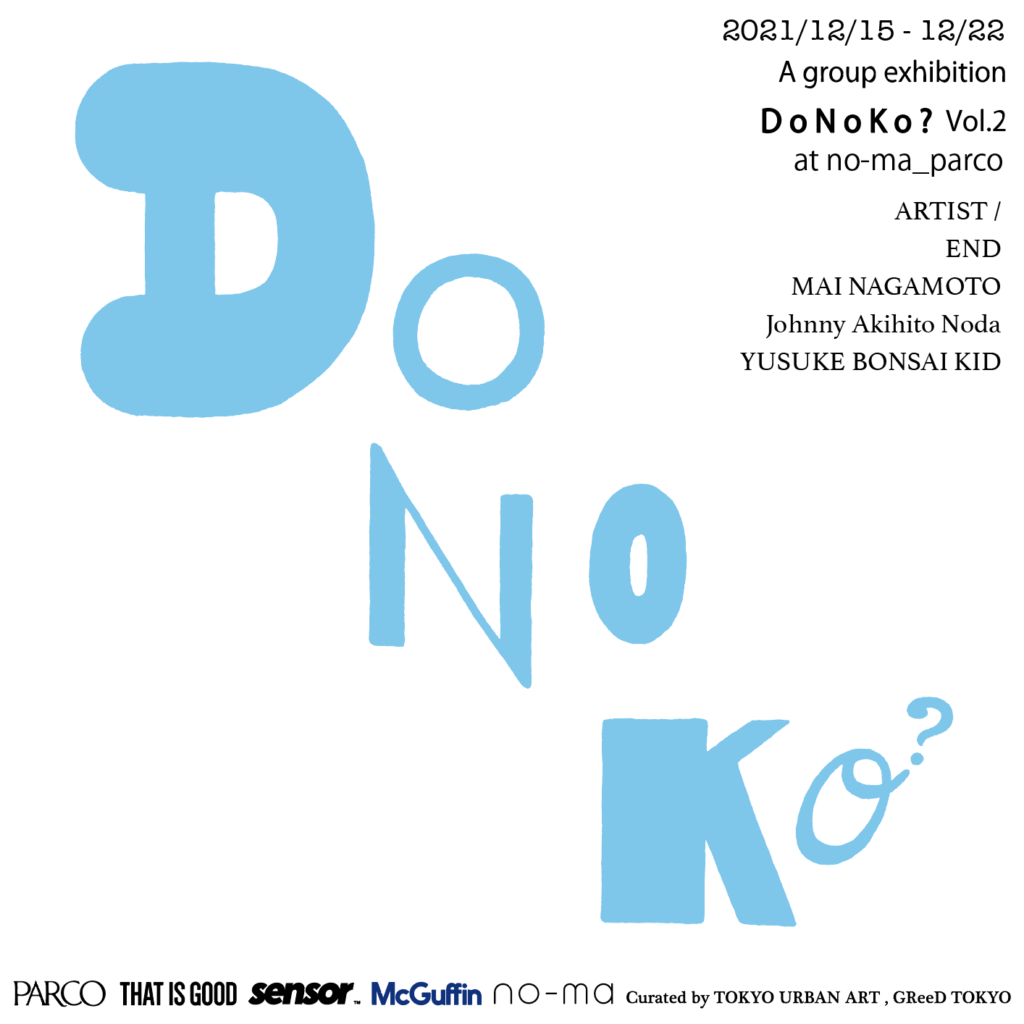
2021/12/15-12/22
A group exhibition
D o N o K o ? Vol.2
Curated by TOKYO URBAN ART , GReeD TOKYO
at @noma__official
ARTIST /
END
MAI NAGAMOTO
Johnny Akihito Noda
YUSUKE BONSAI KID
1ヶ月に1回くらいのペースで様々なアーティストの濃すぎる考え方やエピソードに触れてきたわけですが、今回は4人展ということで、それぞれ1人ずつににインタビューを敢行!!怒涛のペースで更新します。(ひぃぃぃ。。※心の声)
いずれも表現領域、方法論、思想が全く異なり、どれも濃い話になっていますので、全て漏れなくチェックしてください!
Every month or so, I’ve been interviewing various artists about their thoughts and episodes, and this time, since it’s an exhibition of four artists, I’m going to interview one of each!
I’ll be updating at a furious pace.( OMG. ※Voice of the mind)
All of them have completely different areas of expression, methodologies, and ideologies, and each one is a rich story, so be sure to check them all out!
第一弾はENDさん。
まず皆さんはハードコアという音楽ジャンルをご存知でしょうか?
1970年代、セックス・ピストルズがもたらしたパンク・シーンの狂騒以降、主にアメリカ、イギリスで独自に、よりラディカルに、スピーディーに、そして各思想におけるアナーキズム精神を強め進化を遂げながら、局地的に世界中にシーンが存在する音楽ジャンルです。
The first article is about END.
First of all, have you ever heard of the music genre called hardcore?
Since the madness of the punk scene brought about by the Sex Pistols in the 1970s, it has evolved independently in the U.S. and U.K., becoming more radical and speedy, and strengthening the spirit of anarchism in each ideology, and is now a musical genre with its own local scene in each country.
その過激さ故になかなか日常ではキャッチアップする機会がないのが正直なところですが、日本でもシーンはしっかりと根付いていて、今回のENDさんはハードコアという音楽シーンに”絵”という形で関わり続けてきたシーンにおいての重鎮です。
(前置きで話した部分でいうとなんだか過激でおっかない人に思えるかもしれませんが、ご本人は至って穏やかでカッコいい大人を体現しているような方でした!)
To be honest, due to its extreme aspect, we don’t have many opportunities to encounter it in our daily lives, but the scene is firmly rooted in Japan, and END is a major figure in the scene who has been involved in the hardcore music scene in the form of “painting”.
(Just from what I said in the introduction, he may seem like an aggressive and dangerous person, but he was the embodiment of a calm and cool gentleman!)
そんなこんなで前編は、活動のルーツと密接しているアンダーグラウンドなハードコアシーンの実態も含めてご紹介していこうと思います。どうぞ!
So in the first part of this article, I’d like to introduce him and the underground hardcore scene that is closely related to the roots of his activities. Go ahead!
−絵の活動以外にもセレクトショップをやっているという話もお聞きしました。
絵の活動を中心にして、自分の店をアトリエ兼洋服のセレクトショップとしてやっています。自分の絵や、友達の絵が展示できるスペースでもありますね。
-I heard that in addition to painting activities, you also run a boutique.
I mainly focus on my painting activities and run my own store as a studio and clothing boutique. It’s also a space where I can exhibit my own paintings and those of my friends.
−自分自身の作品とクロスオーバーはしているのでしょうか?
全く普通のウェアで、作品とは差別化しています。いわゆるストリートブランドです。
OLDXが僕のブランドで、カレッジ系の雰囲気やポップで着やすい服を手がけています。
アパレル自体は、20代前半から先輩がやっていたブランドで働いていて、そのブランドの直営店を渋谷に出した時に今のブランドとは全く別ですけど自分のブランドもやらせてもらっていました。そういう経験からある程度のノウハウはわかっていたので、今の自分のブランドを始めたときに自分の好きなようにできたらなぁと…。
-Do you have any crossover with your own work?
Totally normal clothes, differentiated from the works. It is a so-called street brand.
OLDX is my brand, and I work on clothes that have a collegiate vibe, pop and comfortable to wear.
I have been working in apparel since I was in my early twenties for a brand owned by one of my seniors, and when that brand opened a directly managed store in Shibuya, I was allowed to work on my own brand, although it was completely different from the current brand.
I knew a certain amount of know-how from that experience, so when I started my own brand, I wanted to be able to do what I wanted…
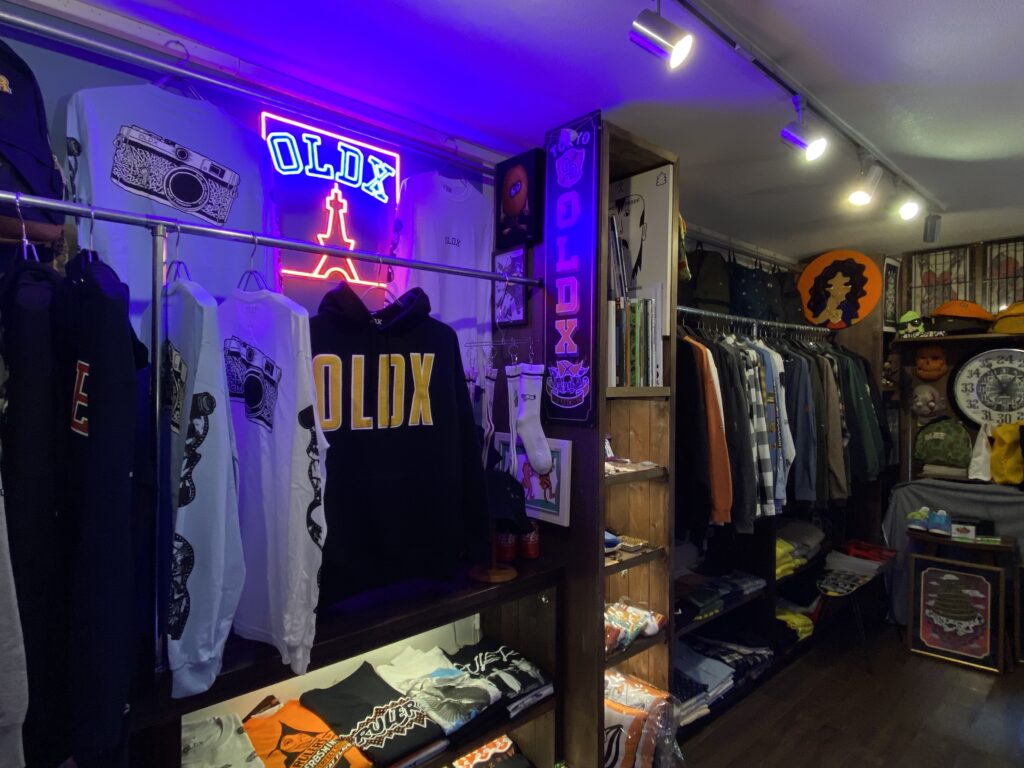
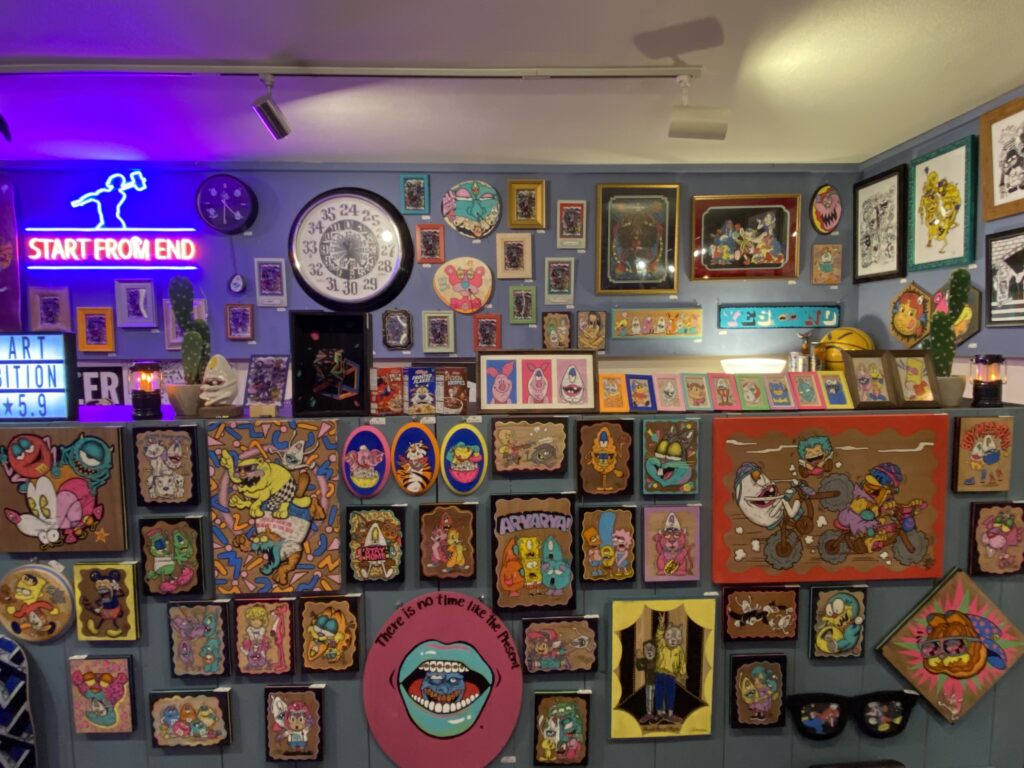
セレクト&ギャラリーショップGReeD TOKYO。ENDさんの手がけるOLDXのウェアや、展示もされている。まさにカルチャーが詰まった空間。
GReeD TOKYO is a select and gallery store where you can find END’s OLDX clothing and exhibitions. It’s a space filled with culture.
−アパレルと絵はどちらを先に始めたのでしょうか?
絵が先ですね。小さい頃から、ファミコンのカセットのキャラクターとかを描いたりしていました。あとは今もずっと好きですけどヴィンテージのアメコミなどのタッチや世界観が好きで、スパイダーマンとかグレムリン、ゴーストバスターズとか好きですね。日本の漫画もアラレちゃんとか昔のモノは好きですけど、日本の漫画からはそこまで影響を受けてはいないですね。
でも色々と好きなので描きたいと思った時に気にせず色々なものを描いてはいますが。
-Which did you start with first, apparel or painting?
Picture first. Ever since I was little, I used to draw characters for NES cassettes and such. I also like the touch and world of vintage American comics, such as Spider-Man, Gremlins, and Ghostbusters. I also like old Japanese manga like Arare-chan, but I’m not that influenced by Japanese manga.
But I like a lot of things, so when I want to draw something, I draw it without worrying about it.
−アーティストとして本格的に活動を始めたタイミングは?
2000年代から本格的に趣味問わず描き始めて、2007年にNUMBという東京を代表するハードコアバンドがワンマンでショーをやる時に、初めて自分が手描きで描き起こしたフライヤーが正式に世の中に出たって感じです。その画風が2007年という時代に逆にフィットした感じもあって、周りからの評判も良くて…すごく嬉しかったですね。
そこから友達のバンドだとか、自分もハードコアは好きなので足を運んだ先の繋がりとかで依頼が来る様になって、ハードコアの世界でENDというアーティストが確立されていったという形でしょうか。
-When did you start working as an artist in earnest?
I started drawing in the 2000’s as a hobby, and in 2007, when NUMB, one of Tokyo’s leading hardcore bands, was doing a one-man show, the first flyer I drew by hand was officially released to the world. I felt that my style of drawing fit the time period of 2007, and it was well received by the people around me… I was very happy.
From there, you started getting requests from your friends’ bands and from people you visited who also liked hardcore, and I became established in the hardcore world…
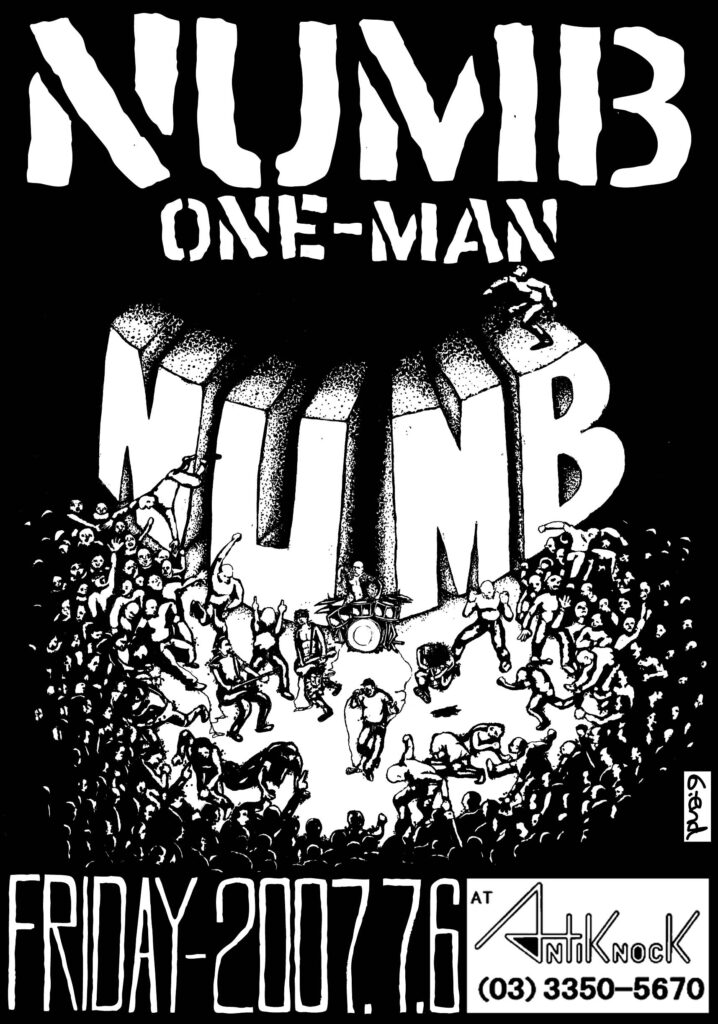
※NUMB(バンド)…1995年から活動を行なっている東京を代表するハードコア・バンド。海外でも知名度があり、今も活躍中。
※NUMB : Tokyo’s leading hardcore band, active since 1995. They are also well known overseas.
−活動のスタートはやっぱりハードコアからだったのですね。ハードコアはいつから好きだったのでしょうか?
ハードコアの音楽のカルチャーに携わっていったのが10代の後半から。
それまでは色々な音楽を聴いていましたけど、なんかハードコアミュージックがシックリきました。特にニューヨークハードコアと呼ばれているジャンルが好きです。
-Your career always started with hardcore, didn’t it? When did your love for hardcore begin?
I became involved in the hardcore music culture in my late teens.
I listened to a lot of different kinds of music before that, but hardcore music just felt right to me. I especially like the genre known as New York hardcore.
−どういう所がシックリきましたか?
そもそもカウンターカルチャーが好きなんです。みんなが右向いたら自分は左向くようなところがあって、良く言うとマイペースなのですが、同時に自分にとって良いものは良いって胸を張って言えるスタイルでいたい(笑)そんな人たちが多く集まっている場所が自分にとって居心地が良かったんじゃないかなあ。
中には社会からズレていく人もたくさん見てきましたが、そもそも学生時代などでズレてた人たちが多く集まっているので、それはそれでしょうがないというか(笑)
とにかく自由で、好きな音楽や好きなファッションスタイルが自分にはカッコよく映っていたんです。
それは絵にも反映されていて、絵にも流行ってあるけど、自分はその波みたいなものの逆を行く…じゃないですけど。
デジタルが主流ならアナログで、赤が流行りなら青でみたいなね。
でも、実際こういうローカルなシーンで、そこに寄り添っていくアーティストって、日本にはあまりいないですよね。
-What is it that makes you feel so good?
I like the counterculture to begin with. When everyone else is looking to the right, I tend to look to the left. I’m a self-paced person to put it nicely, but at the same time, I want to be able to say with pride that what’s good for me is good for me lol I guess I felt comfortable in a place where many such people were gathered.
I’ve seen a lot of people who are out of step with society, but I guess that’s just the way it is, since there are a lot of people like that in school lol
Anyway, being free, the music I liked and the fashion style I liked seemed cool to me.
It’s also reflected in my paintings. There are trends in painting, but I’m going against the grain, you know?
If digital is the mainstream, I’ll go analog; if red is popular, I’ll go blue.
But in fact, there aren’t many artists in Japan who are in tune with the local scene like this.
−それはなぜなのでしょうか?
パンクとかハードコアって商業的ではないので、情熱先行でやるしかなくて、お金がついてこないんですね。そうなると、受ける側もコンスタントにやらなくなってくる。だから本当に好きじゃないと続かないですよね。時間と労力がやっぱりかかるから、やっぱりどこかで欲がでちゃうじゃないですか、人間なんで(笑)
自分はこのシーンが好きなので、お互いにフックアップしながらやっていこうと思えるんですけどね。
自分もそうですけど他の仕事をしながら絵をずっと描いているアーティストもたくさんいて、それはある一定の生活できる収入が他にあるから自由にできて心に余裕があるんだと思います。
だからこのシーンのみで生活なんて普通に考えたら難しいと思う、バンドでさえ難しいと思うからそのアートワークを担当しているアーティストなんてもっと難しいよね。
だから情熱があってずっとその世界観を見ていきたいと思っているアーティストは、こういった音楽シーンから求められていくのかなって。
こういうカルチャーは世界中にあって、海外には多い文化だけど、絵を描くアーティストとバンドとの関係、お互いにフックアップし合いながら関係を作る形は日本では少ないと感じています。
もっと身近で絵を描いている友達などを増やして自分たちの世界観をつくっていければ、きっと新しいバンドが増えていくと同じように音楽シーンの中で新しい絵描きも増えていく様な気がします。
-How can that be?
Punk and hardcore are not commercial, so you have to do it with passion, and money doesn’t come along. If that’s the case, the people who receive the music won’t do it consistently. So you have to really like it to continue. It takes a lot of time and effort, so you end up getting greedy somewhere, because we’re all human lol
I like this scene, so I think we can work together and help each other.
Like myself, there are a lot of artists who work at other jobs and paint all the time, and I think that’s because they have a certain income to live on, so they are free to do what they want and have room in their hearts.
It’s hard to make a living only in this scene, even for a band, so it’s even harder for an artist who is in charge of the artwork.
That’s why I think artists who are passionate and want to continue to see the world will be sought after by this kind of music scene.
This kind of culture exists all over the world, and I feel that the relationship between the artist who draws the pictures and the band, the way they cooperate with each other to create a relationship, is less common in Japan.
−僕はハードコアについて詳しい訳ではないのですが、ネットで音楽に対して多様性が進んだ現在でも他の音楽ジャンルなどに比べてクロスオーバーしていないというか不変性みたいなものを感じる印象です。
そうですね。だから極端に言うと多分ですが毎回同じ様な客を相手に好きな仲間たちと対バンするという感じで、同じ人がずっと同じ場所で遊んでいるような流れがある様な気が昔からします。常にある一定の数がずーっと何年も居続けれる場所というか。それは良いことでもあるしそれ以上大きくもならないけど無くなりもしない世界のような気がします。
でも、それが美学でもあり、良くも悪くも成り立っている部分だと思いますね。本当にこのカルチャーが好きな人達が毎回集まれる場所的な感じですよね。
世間の人達にみんなで一緒に~なんちゃら~ではなく、このカルチャーが好きな奴はこい!一緒に遊ぼう!みたいな感じですよね。それが最高なんですけどね(笑)
絵描きもバンドも共通して言えますが売れたいとは言っていても、売れるとセルアウトだなんだのって周りから言われることもあり(笑)、コアなファンには受け入れられなかったり、本人たちも実際に広がってみるとなんとなくズレていってしまったり…という様なこともありますよね。
-I’m not an expert on hardcore, but I get the impression that even with all the diversity in music on the internet today, it’s not as crossover or constant as other music genres.
That’s right. So, to put it in an extreme way, it’s like you’re playing to the same kind of audience every time with the same kind of friends you like, and it’s always been like the same people are playing in the same place all the time. It’s a place where a certain number of people can always stay for years. It’s a good thing, and I feel like it’s a world that won’t get any bigger, but also won’t disappear. But I think that’s the beauty of it, and that’s what makes it both good and bad. It’s like a place where people who really like this culture can gather every time.
It’s the same for both artists and bands, but even if you say you want to sell your work, when you do, people will say you’re selling out (lol), the core fans won’t accept you, and when you actually start to spread your work, you become somewhat out of sync.
−好きだったアーティストが売れたら寂しくなるファン心理って「あるある」だと思いますけど、ハードコアは結束力が強い分、その反動は大きそうですね…。
そういうのは色んなジャンルの音楽シーンや他文化でも同じだと思います。ハードコアシーンは一つのファミリーじゃないですけど…、自分の周りを、自分の周りのアーティストたちや仲間とかによる小さいコミュニティで回していくことが、僕らの理想だったりもしますからね。
-I think there is a certain kind of fan psychology that gets lonely when an artist you liked sells out, but hardcore seems to have a big backlash because of its strong unity…
I think it’s the same in the music scene of various genres and other cultures. The hardcore scene is not a single family, but it’s our ideal to run a small community of artists and friends around us.
−自分たちのコミュニティを資本的な部分でも自分たちで回すようなイメージですね。
いま僕は40代だけど、衣食住やっている仲間達で小さな経済が回っていけば、それは幸せだなと思います。
ホテルなど宿泊施設をやっている友達がいて、飲食やっている友達がいて、洋服買うならここがあって、楽器やレコードが欲しければあの友達のところに行って…お金を使って回すという形ですよね。それで好きな仲間の生活が出来ていくなら最高じゃないですか。なかなか現実的には難しいですが理想はそうですね、だからまわりの友達のお店などが増えていくと嬉しいです。
-It’s like you’re running your own community, even the capital part of it.
I’m in my 40s now, and I think I’ll be happy if I can keep a small economy going with my friends who are doing food, clothing, and living.
I have friends who run hotels and other accommodations, and friends who run restaurants… If I want to buy clothes, I go here, if I want to buy musical instruments or records, I go to my friend… It’s a way of spending money and turning it around. Wouldn’t it be great if you could make a living with the people you love? It’s difficult to do in reality, but ideally, yes. So it would be great to see more and more of my friends’ stores around me.
−日本のハードコアシーンってENDさんの立ち位置も含めて、どういう状況なのでしょうか?
どうでしょうか、プレイヤー側じゃないので何ともいえませんが。海外と比べて恐らく何かが違うのも確かで、でもその何かってよくわからないけど(笑)
もちろん日本で売れているバンドも沢山いますよ。ハードコアシーンは特殊なんで一言では言えないですよね。
だから割と僕のやっていることは特殊といえば特殊なのかもしれないね。ハードコアカルチャーの絵をアートにしているというアーティストはやっぱり少ないと思うな。
立ち位置的にはどうなんだろう、でも十数年やっていてこのカルチャーのショーフライヤーで見てくれている人は増えていってるから、一つのスタイルにはなっていってるんじゃないかな。今は他のショーフライヤーを見ると色々な手描きのスタイルで描いているのをよく見るので自分もたくさん刺激を受けてますよ。やっぱり色々な絵が世の中にあふれているのは楽しいですもんね。
あ、そうそう基本的にショーフライヤーの絵を描くときはお金もらっていないんですよ。
-What is the situation of the hardcore scene in Japan, including the position of END?
I don’t know, I’m not on the player side, so I can’t say. I’m sure there’s something different about Japan compared to other countries, but I don’t know what that something is lol
Of course, there are many bands that sell well in Japan. The hardcore scene is very unique, so it’s hard to put it into one word.
That’s why what I’m doing is rather unique, I guess. I don’t think there are many artists who make art based on hardcore culture.
I’m not sure where I stand, but I’ve been doing this for over ten years and the number of people who see my show flyers in this culture is increasing, so I think it’s becoming a part of my style. Nowadays, when I look at other show flyers, I see many different hand-drawn styles, which inspires me a lot. It’s fun to see so many different kinds of drawings in the world, isn’t it?
Oh yeah, basically, I don’t get paid when I draw the show flyers.
−えぇっ!!お金取っていないんですか!?
そうなんですよ。一回ももらったことがなくて。
お互いにWIN -WINな関係でいきたいと思っていて、バンドも僕に頼んでプラスになって、僕もそのフライヤーを描いて自分の価値が上がる、という様にお互いに良いモノになれば…。
フライヤーなんて基本配るためのものじゃないですか、基本はお金かけないものなので、まあお金はもらわないですよね。
僕にとってはそれが美学。
-Wow! You’re not taking any money?
That’s right. I’ve never received one before.
I’d like to have a win-win relationship with both sides, with the band getting something positive by asking me to do it, and me getting something positive by drawing the flyer and increasing my own value.
Flyers are basically for handing out, and since they don’t cost money, well, I don’t get paid for them.
For me, that’s the aesthetic.
−美学!ストイックな世界ですね!
結構「幾ら?」って聞かれることもありますけど「いやいや良いよ」って。
その代わり好きなバンドや自分がやりたいなと思った企画しかやらないですね。だから世界観を含め自分の好きなタッチで描けるし。
そもそもバンドカルチャーってお金ないですからね(笑)
だからコンビニコピーや出力センターでフライヤーも印刷しているし。同じ理由でこの手のフライヤーは白黒ベースなんですよ。1番安い方法で刷るんです。でも、その雰囲気が好きだから僕も描くんですけどね。最近はカラーでも安いものもあるのでみんな色々なフライヤーを作っていて、見ていて楽しいなって思っています。
-Aesthetics! It’s a stoic world!
I’ve been asked, “How much? but I say, “No, no, it’s fine”.
Instead, I only do projects for bands I like and projects that I want to do. That’s why I can draw with my own touch, including the world view.
In the first place, bands don’t have a lot of money lo
That’s why we print our flyers at convenience stores and output centers. It’s the same reason why these flyers are printed in black and white. It’s the cheapest way to print them, but I like the atmosphere, so I draw them too. Nowadays, color flyers are also available at reasonable prices, so people are making all sorts of flyers, and it’s fun to see.
−音楽といえばライブ時に売っているバンドTシャツとかのイメージもありますけど、そういったものは?
バンドが僕の絵をTシャツにするときは、バンド側が僕の絵を使って商売をするってことだから、その対価としてギャランティを貰ったりしますけど、僕からはあんまり言わないですね。
フライヤーのデザインをそのままTシャツにして売るって時は同じくギャランティーがありますね。
基本的にはお金のないシーンなので、ぼくも望んでいないです。まあ相手次第で、リスペクトがあるかどうかの話ですね。もちろんバンドの規模によってはちゃんと仕事として描いている時もありますけどね。本当にローカルシーンで活動している所には熱意で応えたいという思いがあります。
-When I think of music, I also think of band T-shirts that are sold at live shows, do you have anything like that?
When a band uses my drawings for a T-shirt, they are doing business with me, and I get paid for that, but I don’t say much.
If they sell the t-shirts based on the flyer design, there is a guarantee as well.
Basically, it’s a no-money industry and I don’t want it either. It depends on the artist and if there is mutual respect. Of course, depending on the scale of the band, there are times when I paint it as a job. I really want to respond with enthusiasm to those who are active in the local scene.
−先ほど仰っていたご自身の“価値が上がる”というのは、どのようなポイントでの話なのでしょうか?
シーンに貢献していることで必要不可欠な存在になっているかどうか、という話ですね。
例えば海外のハードコアバンドが来日した時や少し大きなイベントがある時に、自然に誘われて描くのを頼まれることとか、周りのバンドから定期的に頼まれることとか、自分から発信をしなくても周りが求めてくれているので、それが僕にとっての「やってよかった」と思える部分です。
-What is the point of “increasing your value” that you were talking about earlier?
It’s about whether or not you’re contributing to the scene and becoming an indispensable part of it.
For example, when foreign hardcore bands visit Japan or when there is a big event, I am naturally invited and asked to draw them, or I am regularly asked by the bands around me, etc. Even if I don’t send out any messages myself, the people around me are asking me to do so, and that is the part that makes me feel “good” about what I do.
ちなみにフライヤーを見せてもらいながらエピソードをお聞きしていたのですが、すごく意外なエピソードもありました。
By the way, while showing us the flyers and asking about the episodes, there were some very unexpected episodes.
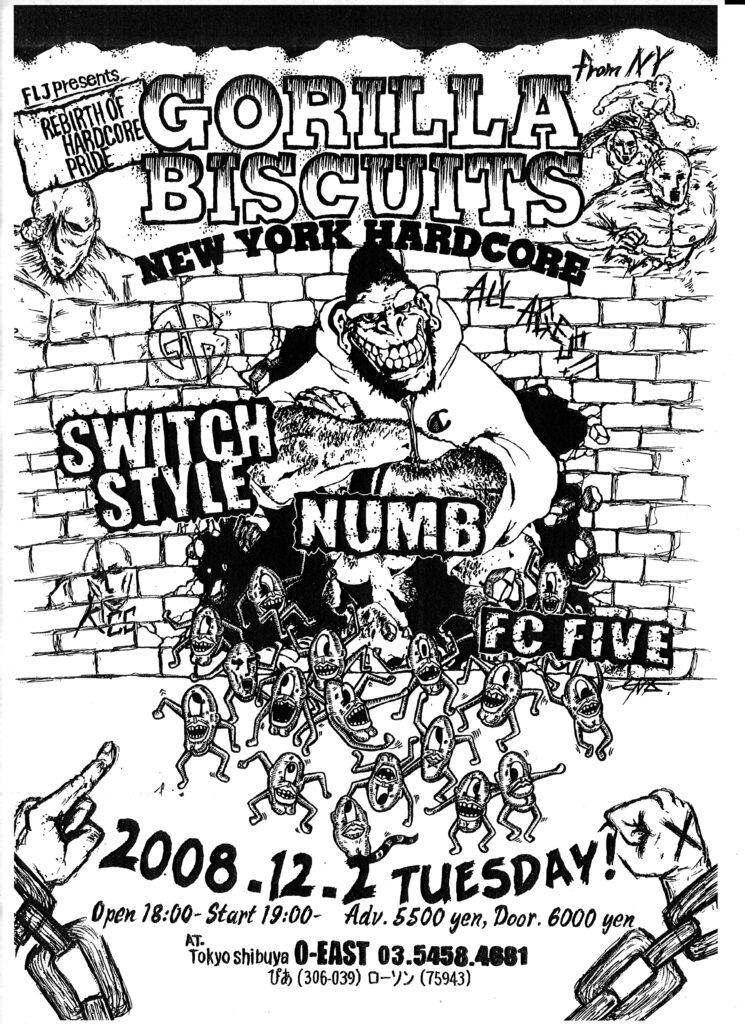
(写真を指差しながら)これがゴリラ・ビスケッツという、80年代から活動しているバンドで、みんなが何かしら影響を受けたニューヨークのレジェンドバンドの来日時に描いたフライヤーです。
こちらはNUMBで、そのメンバーの同級生のバンドで、レジェンドであるSwitch Styleです。ドラマーがZOZOTOWNの元社長の前澤友作くんですね。
Switch StyleのボーカルのYURI君がいまNUMBでギターをやっています。
ちなみにゴリラ・ビスケッツの有名なアルバムのタイトルがスタート・トゥディです。
(Pointing to the photo) This is a flyer I drew when Gorilla Biscuits, a legendary band from New York that has been active since the 80’s and has influenced everyone in some way, came to Japan.
This is NUMB, the band of the member’s classmate, the legend, Switch Style. The drummer is Yusaku Maezawa, the former president of ZOZOTOWN.
YURI, the vocalist of Switch Style, is now playing guitar in NUMB.
By the way, the title of Gorilla Biscuits’ famous album is “Start Today”.
※ゴリラ・ビスケッツ(バンド)…ロックの基本ライフスタイルである「セックス、ドラッグ、ロックンロール」を否定した理念であるストレート・エッジのムーブメントの旗手に数えられるニューヨークのハードコア・バンド。80年代後半に活動。
※Switch Style (バンド)…NUMBと同じく東京を代表するハードコア・バンド。(現在は活動していません)Wikipedia大先生によると前澤友作さんの当時の名前はYOU X SUCK表記だったらしい。すげえ。
※Gorilla Biscuits : A hardcore band from New York City, one of the standard bearers of the “straight edge movement,” a philosophy that rejected the basic rock lifestyle of “sex, drugs, and rock and roll”.
※Switch Style : A hardcore band representing Tokyo as well as NUMB. (The band is no longer performing) According to Wikipedia, Yusaku Maezawa’s name at the time was YOU X SUCK. It’s incredible.
−ええっ、前澤さんってバンドマンだったんですね!しかもハードコア出身!
(笑)今の彼しか知らない人はみんな驚きますよね。自分たちがハードコアキッズだった頃、衝撃を与えたバンドの一つですね。2008年にゴリラ・ビスケッツがオリジナルメンバーで来日した時にSwitch Styleも1日だけ復活しました。結構思い入れが深いフライヤーです。
-So Maezawa was a band member! And from a hardcore background!
LOL People who only know him now would be surprised. People who only know him now would be surprised. When we were hardcore kids, he was one of the bands that made a big impact on us, and when the Gorilla Biscuits came to Japan in 2008 with the original members, Switch Style came back for one day. It’s a flyer that I’m very attached to.
…ということで、ENDさんのインタビュー前編でした。
JAPAN CULTUREの発信をする当メディアとしてはENDさんと一緒にジャパニーズ・ハードコアシーンにも興味を持ってもらえると非常に嬉しいです!
次回は作品についての話を深掘りして聞いていきます!
…That was the first part of the interview with END.
As a media outlet dedicated to the dissemination of JAPAN CULTURE, we’d be very happy if you’d take an interest in the Japanese hardcore scene with END-san!
Next time, we’ll talk about his work in depth!
文:THAT IS GOOD 編集部 古賀
TEXT : THAT IS GOOD editorial department, Koga
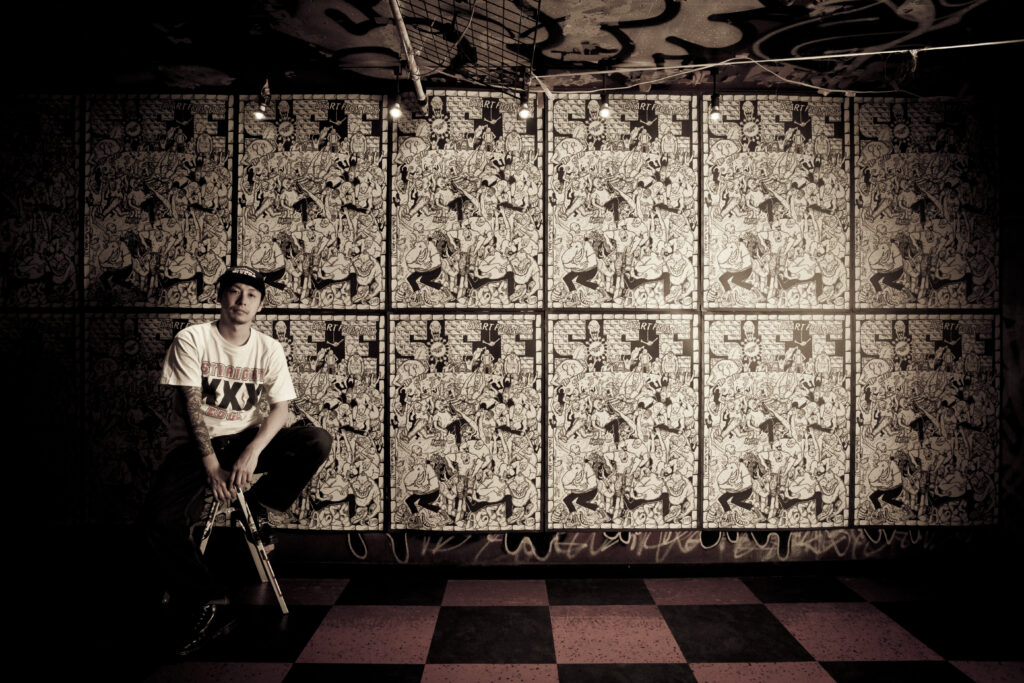
Flyer Artist 東京出身
国内外のHARDCOREやPUNKシーンのフライヤーを中心にアーティストとして活動中。
自身が影響を受けた80、90年代のUS HARDCOREやPUNKのフライヤーを現代のフライヤーへと継承する姿勢や信念が特徴的。
自身の活動する場所やバンドなどに絵を提供しつつ、個展やライブペイントなどで自身の個性も表現している。
「誰かにとっては意味の無いことだけど、誰かにとっては意味のあることなんだ」という言葉を信念に、現在も止まらず描き続けている。
また、”円度”名義として和紙や緻密な線画などの手法を使った「和」を全面に出す作品製作に取り組んでいる。
数年に一度個展も開催し、アーティストとしての和と洋の世界観幅を広げている。
Flyer Artist from Tokyo
Currently working as an artist for flyers of HARDCORE and PUNK scenes in Japan and abroad.
He has a characteristic attitude and belief that the US HARDCORE and PUNK flyers of the 80’s and 90’s, which he was influenced by, should be passed on to modern flyers.
While providing pictures for the places and bands where he works, he also expresses his own personality through solo exhibitions and live painting.
He believes in the phrase, “What is meaningless to someone else is meaningful to someone else,” and continues to draw without stopping.
He also works under the name of “円度 (Endo in Kanji)”, using Japanese paper and precise line drawings to create works with an overall sense of ” Japanese”.
He holds a solo exhibition once every few years, and is expanding the range of his worldview as an artist, both Japanese and Western.